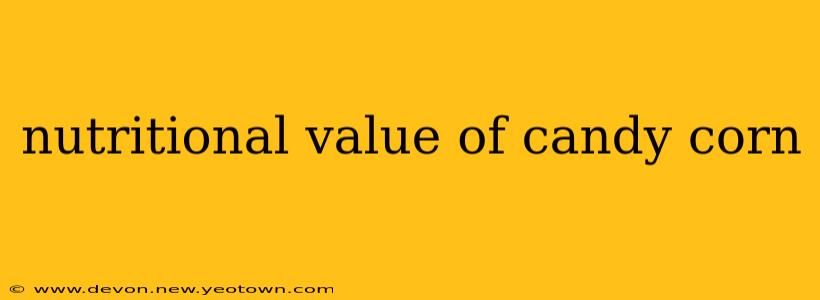Candy corn. That iconic, tri-colored confectionery treat. It's a Halloween staple, a nostalgic delight for many, and...well, not exactly a nutritional powerhouse. Let's dive into the surprisingly complex (and frankly, underwhelming) nutritional value of candy corn, unraveling its sugary secrets. This isn't a condemnation of candy corn – it's an honest look at what you're actually consuming when you indulge in this seasonal favorite.
What are the main ingredients in candy corn?
Candy corn's main ingredients are fairly simple: sugar, corn syrup, corn starch, salt, and artificial colors and flavors. This simple ingredient list is a pretty clear indicator of its nutritional profile. The high sugar content dominates, leaving little room for significant vitamins, minerals, or fiber. It's essentially pure sugar, cleverly disguised in a waxy, cone-shaped package.
What are the calories in candy corn?
A typical serving size of candy corn (around 14 pieces) clocks in at approximately 150 calories. These calories are almost entirely derived from carbohydrates, primarily sugar. This high-sugar, low-nutrient profile makes it a treat best enjoyed in moderation. Let's be honest, it's not the kind of snack that's going to contribute to a balanced and healthy diet.
Is candy corn good for you?
This is where we get to the heart of the matter. No, candy corn is not good for you in the sense of providing essential nutrients. It lacks vitamins, minerals, and fiber. The high sugar content contributes to empty calories, meaning calories without significant nutritional benefits. Excessive consumption can lead to weight gain, increased risk of tooth decay, and potential blood sugar spikes.
Think of it this way: a small handful might satisfy a sweet craving, but it shouldn't be a staple in your diet.
Does candy corn have any nutritional benefits?
While candy corn offers virtually no nutritional benefit, it’s worth noting that the modest amount of corn syrup and cornstarch do provide tiny amounts of carbohydrates, which the body uses for energy. But this is far outweighed by the significant sugar content. Let's not pretend candy corn is a health food – it's not.
How much sugar is in candy corn?
The sugar content is quite high. A typical serving contains a substantial amount of added sugars, which contribute to the overall calorie count and can negatively impact health if consumed regularly in large quantities. This high sugar concentration is the primary reason why candy corn is not considered a health-conscious choice.
What are the health risks of eating candy corn?
The primary health risk associated with candy corn consumption is the high sugar content. Excessive sugar intake can lead to weight gain, increased risk of type 2 diabetes, heart disease, and tooth decay. Moderation is key – enjoy it as an occasional treat, not a regular part of your diet.
Are there healthier alternatives to candy corn?
Absolutely! There are plenty of healthier alternatives to satisfy your sweet cravings without the sugar overload. Consider fruit, dark chocolate (in moderation), yogurt with berries, or even homemade treats made with natural sweeteners and whole grains. These options offer nutrients and fiber, providing satisfaction without the negative health consequences.
In conclusion, candy corn offers a fun, nostalgic experience, but it's crucial to remember its limited nutritional value and potential health impacts if consumed excessively. Enjoy it sparingly and savor the experience, knowing that a balanced diet is always the best approach to maintaining good health.

